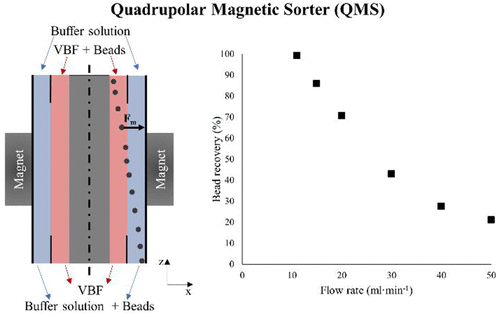当前位置:
X-MOL 学术
›
Ind. Eng. Chem. Res.
›
论文详情
Our official English website, www.x-mol.net, welcomes your
feedback! (Note: you will need to create a separate account there.)
Recovery of Magnetic Catalysts: Advanced Design for Process Intensification
Industrial & Engineering Chemistry Research ( IF 3.8 ) Pub Date : 2021-09-22 , DOI: 10.1021/acs.iecr.1c03474 Cristina González-Fernández 1 , Jenifer Gómez-Pastora 2 , Eugenio Bringas 1 , Maciej Zborowski 3 , Jeffrey J Chalmers 2 , Inmaculada Ortiz 1
Industrial & Engineering Chemistry Research ( IF 3.8 ) Pub Date : 2021-09-22 , DOI: 10.1021/acs.iecr.1c03474 Cristina González-Fernández 1 , Jenifer Gómez-Pastora 2 , Eugenio Bringas 1 , Maciej Zborowski 3 , Jeffrey J Chalmers 2 , Inmaculada Ortiz 1
Affiliation

|
The design of microdevices in which components with magnetic character must be separated and recovered from reactive media benefits from the advantages of microfluidics and meets the criteria for process intensification; however, there are open questions, such as the design of the most appropriate magnet arrangement, that need further research in order to increase the magnetic gradient exerted on the particles. Herein, we focus on the continuous recovery of magnetic microparticles, that can be used as support to facilitate the recovery of biocatalysts (magnetic microcatalysts, MMCs) from biological fluids. We analyze and compare the performance of two typical magnetophoretic microdevices for addressing bead recovery: (i) annular channels with a quadrupole orientation of the permanent magnets (quadrupole magnetic sorter, QMS) and (ii) the standard design, which consists of rectangular channels with a single permanent magnet to generate the magnetic field. To this end, an experimentally validated computational fluid dynamics (CFD) numerical model has been employed. Our results reveal that for devices with the same width and length, the micro-QMS, in comparison to a rectangular channel, could accomplish the complete particle retrieval while (i) processing more than 4 times higher fluid velocities, treating more than 360 times higher flow rates or (ii) working with smaller particles, thus reducing by 55% the particle mass. Additionally, the parallel performance of ≈300 micro-QMSs fulfills the processing of flow rates as high as 200 L·h–1 while entirely capturing the magnetic beads. Thereby, this work shows the potential of the QMS advanced design in the intensification of the recovery of catalysts supports of magnetic character.
中文翻译:

磁性催化剂的回收:工艺强化的先进设计
必须从反应介质中分离和回收具有磁性的成分的微器件的设计受益于微流体的优点并符合工艺强化的标准;然而,还有一些悬而未决的问题,例如最合适的磁铁排列的设计,需要进一步研究以增加施加在颗粒上的磁梯度。在此,我们专注于磁性微粒的连续回收,磁性微粒可用作载体以促进从生物体液中回收生物催化剂(磁性微催化剂,MMCs)。我们分析和比较了两种典型的磁泳微器件的性能,用于解决珠回收:(i)具有四极定向永磁体的环形通道(四极磁选机,QMS) 和 (ii) 标准设计,由矩形通道和单个永磁体组成以产生磁场。为此,采用了经过实验验证的计算流体动力学 (CFD) 数值模型。我们的结果表明,对于具有相同宽度和长度的设备,与矩形通道相比,微型 QMS 可以完成完整的粒子检索,同时 (i) 处理高出 4 倍以上的流体速度,处理高出 360 倍以上流速或 (ii) 使用较小的颗粒,从而减少 55% 的颗粒质量。此外,≈300 个 micro-QMS 的并行性能可满足高达 200 L·h 的流速处理 已采用经过实验验证的计算流体动力学 (CFD) 数值模型。我们的结果表明,对于具有相同宽度和长度的设备,与矩形通道相比,微型 QMS 可以完成完整的粒子检索,同时 (i) 处理高出 4 倍以上的流体速度,处理高出 360 倍以上流速或 (ii) 使用较小的颗粒,从而减少 55% 的颗粒质量。此外,≈300 个 micro-QMS 的并行性能可满足高达 200 L·h 的流速处理 已采用经过实验验证的计算流体动力学 (CFD) 数值模型。我们的结果表明,对于具有相同宽度和长度的设备,与矩形通道相比,微型 QMS 可以完成完整的粒子检索,同时 (i) 处理高出 4 倍以上的流体速度,处理高出 360 倍以上流速或 (ii) 使用较小的颗粒,从而减少 55% 的颗粒质量。此外,≈300 个 micro-QMS 的并行性能可满足高达 200 L·h 的流速处理 可以完成完整的粒子检索,同时 (i) 处理 4 倍以上的流体速度,处理 360 倍以上的流速或 (ii) 处理更小的粒子,从而减少 55% 的粒子质量。此外,≈300 个 micro-QMS 的并行性能可满足高达 200 L·h 的流速处理 可以完成完整的粒子检索,同时 (i) 处理 4 倍以上的流体速度,处理 360 倍以上的流速或 (ii) 处理更小的粒子,从而减少 55% 的粒子质量。此外,≈300 个 micro-QMS 的并行性能可满足高达 200 L·h 的流速处理–1同时完全捕获磁珠。因此,这项工作显示了 QMS 先进设计在加强磁性催化剂载体回收方面的潜力。
更新日期:2021-11-24
中文翻译:

磁性催化剂的回收:工艺强化的先进设计
必须从反应介质中分离和回收具有磁性的成分的微器件的设计受益于微流体的优点并符合工艺强化的标准;然而,还有一些悬而未决的问题,例如最合适的磁铁排列的设计,需要进一步研究以增加施加在颗粒上的磁梯度。在此,我们专注于磁性微粒的连续回收,磁性微粒可用作载体以促进从生物体液中回收生物催化剂(磁性微催化剂,MMCs)。我们分析和比较了两种典型的磁泳微器件的性能,用于解决珠回收:(i)具有四极定向永磁体的环形通道(四极磁选机,QMS) 和 (ii) 标准设计,由矩形通道和单个永磁体组成以产生磁场。为此,采用了经过实验验证的计算流体动力学 (CFD) 数值模型。我们的结果表明,对于具有相同宽度和长度的设备,与矩形通道相比,微型 QMS 可以完成完整的粒子检索,同时 (i) 处理高出 4 倍以上的流体速度,处理高出 360 倍以上流速或 (ii) 使用较小的颗粒,从而减少 55% 的颗粒质量。此外,≈300 个 micro-QMS 的并行性能可满足高达 200 L·h 的流速处理 已采用经过实验验证的计算流体动力学 (CFD) 数值模型。我们的结果表明,对于具有相同宽度和长度的设备,与矩形通道相比,微型 QMS 可以完成完整的粒子检索,同时 (i) 处理高出 4 倍以上的流体速度,处理高出 360 倍以上流速或 (ii) 使用较小的颗粒,从而减少 55% 的颗粒质量。此外,≈300 个 micro-QMS 的并行性能可满足高达 200 L·h 的流速处理 已采用经过实验验证的计算流体动力学 (CFD) 数值模型。我们的结果表明,对于具有相同宽度和长度的设备,与矩形通道相比,微型 QMS 可以完成完整的粒子检索,同时 (i) 处理高出 4 倍以上的流体速度,处理高出 360 倍以上流速或 (ii) 使用较小的颗粒,从而减少 55% 的颗粒质量。此外,≈300 个 micro-QMS 的并行性能可满足高达 200 L·h 的流速处理 可以完成完整的粒子检索,同时 (i) 处理 4 倍以上的流体速度,处理 360 倍以上的流速或 (ii) 处理更小的粒子,从而减少 55% 的粒子质量。此外,≈300 个 micro-QMS 的并行性能可满足高达 200 L·h 的流速处理 可以完成完整的粒子检索,同时 (i) 处理 4 倍以上的流体速度,处理 360 倍以上的流速或 (ii) 处理更小的粒子,从而减少 55% 的粒子质量。此外,≈300 个 micro-QMS 的并行性能可满足高达 200 L·h 的流速处理–1同时完全捕获磁珠。因此,这项工作显示了 QMS 先进设计在加强磁性催化剂载体回收方面的潜力。











































 京公网安备 11010802027423号
京公网安备 11010802027423号